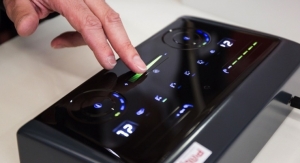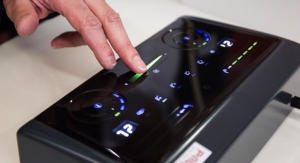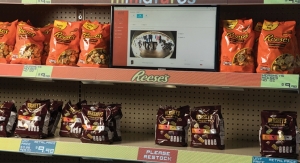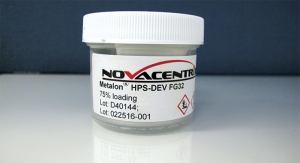David Savastano, Editor03.21.18
In recent years, there has been plenty of examples on how flexible and printed electronics are making inroads into commercial applications. The most notable early example was glucose test strips, a billion-dollar business. There are other early success stories, such as some OLED displays, where flexible systems have advantages as well as RFID, which utilizes printing for antennas.
More recently, there have been moves in a host of newer markets. Interest in sensors has become more prevalent due to the interest in the Internet of Things, autonomous cars and many other applications. Wearables are another area of growth. Meanwhile, RFID is growing rapidly and new possibilities are emerging in the health and wearables space.
One way to find out if there really is growth is by listening to leading brand owners. During LOPEC 2018, speakers from IKEA, Jaguar Land Rover and ABInBev presented their insights into the market. ABInBev, for example, has developed LED- and sensor-enabled plastic beer glasses for the upcoming Word Cup soccer tournament. These cups react to sound by lighting up. Keenan Thompson, who is theglobal innovation director – Packaging Structure, Materials & Design at ABInBev, brought some samples, and they are pretty cool.
Johan Edvardsson, strategic dynamic marking program manager, IKEA of Sweden AB, talked about possible applications for flexible and printed electro cis. He made a use case for smart labels and supply chain projects and said that IKEA is currently taking in proposals for these projects.
The automotive industry has been receiving much attention during the past year, and for good reason. Printed heating systems have long been a staple in cars and trucks. Audi has brought to market OLED tail lights, and more companies are poised to do the same.
There have been significant advances made in developing in-mold electronics systems that reduce the weight and improve efficiencies in electrical systems. There are also unique consoles and touch screens that are being developed that utilize curved and flexible systems. Meanwhile, sensors for internal use, to monitor the cars, as well as external (for autonomous driving) are being created. I have also seen work beign done on sensors that monitor the health of tires.
Ashutosh Tomar, principal engineer (research) with Jaguar Land Rover, made an excellent case for these systems, as well as other possibilities, during his LOPEC talk.
These systems will take some time, of course. Getting the approval of automotive manufacturers is a significant step. However, Tomar noted that potential for unique designs as well as performance benefits – again, think of the lightweight nature of these systems – make the growing use of flexible and printed electronics a question of not if, but how soon.
One more note here: another way of gauging interest in products is by talking to leading suppliers to the industry. At LOPEC, major materials and equipment suppliers told me that in the past, attendees would come up and ask basic questions about the technology, such as what it is and how can it be used. Recently, that focus has shifted to specific questions about applications that are being developed. That is also a good sign.
It is clear that the flexible and printed electronics industry is on the rise, and it will continue to be interesting to see what applications will emerge in the market.
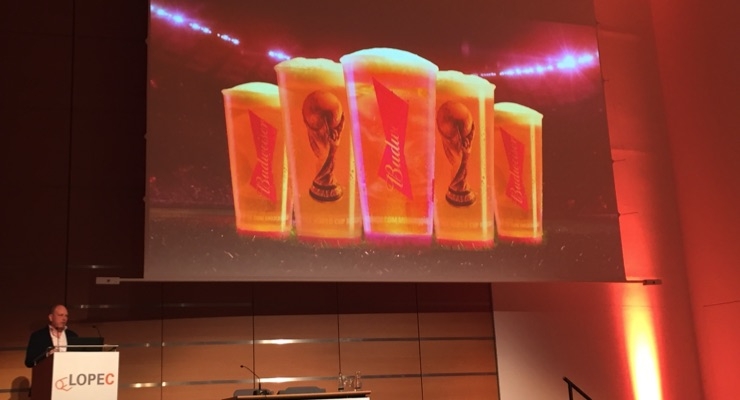
ABInBev's Keenan Thompson shows World Cup glasses at LOPEC 2018
More recently, there have been moves in a host of newer markets. Interest in sensors has become more prevalent due to the interest in the Internet of Things, autonomous cars and many other applications. Wearables are another area of growth. Meanwhile, RFID is growing rapidly and new possibilities are emerging in the health and wearables space.
One way to find out if there really is growth is by listening to leading brand owners. During LOPEC 2018, speakers from IKEA, Jaguar Land Rover and ABInBev presented their insights into the market. ABInBev, for example, has developed LED- and sensor-enabled plastic beer glasses for the upcoming Word Cup soccer tournament. These cups react to sound by lighting up. Keenan Thompson, who is theglobal innovation director – Packaging Structure, Materials & Design at ABInBev, brought some samples, and they are pretty cool.
Johan Edvardsson, strategic dynamic marking program manager, IKEA of Sweden AB, talked about possible applications for flexible and printed electro cis. He made a use case for smart labels and supply chain projects and said that IKEA is currently taking in proposals for these projects.
The automotive industry has been receiving much attention during the past year, and for good reason. Printed heating systems have long been a staple in cars and trucks. Audi has brought to market OLED tail lights, and more companies are poised to do the same.
There have been significant advances made in developing in-mold electronics systems that reduce the weight and improve efficiencies in electrical systems. There are also unique consoles and touch screens that are being developed that utilize curved and flexible systems. Meanwhile, sensors for internal use, to monitor the cars, as well as external (for autonomous driving) are being created. I have also seen work beign done on sensors that monitor the health of tires.
Ashutosh Tomar, principal engineer (research) with Jaguar Land Rover, made an excellent case for these systems, as well as other possibilities, during his LOPEC talk.
These systems will take some time, of course. Getting the approval of automotive manufacturers is a significant step. However, Tomar noted that potential for unique designs as well as performance benefits – again, think of the lightweight nature of these systems – make the growing use of flexible and printed electronics a question of not if, but how soon.
One more note here: another way of gauging interest in products is by talking to leading suppliers to the industry. At LOPEC, major materials and equipment suppliers told me that in the past, attendees would come up and ask basic questions about the technology, such as what it is and how can it be used. Recently, that focus has shifted to specific questions about applications that are being developed. That is also a good sign.
It is clear that the flexible and printed electronics industry is on the rise, and it will continue to be interesting to see what applications will emerge in the market.

ABInBev's Keenan Thompson shows World Cup glasses at LOPEC 2018

